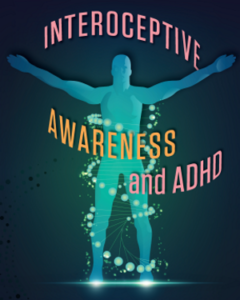Interoceptive Awareness and ADHD
 Interoceptive awareness is the perception of sensations from within the body. Our nervous system senses, interprets, and integrates signals originating from within the body all the time, including our heartbeat, breathing, satiety, as well as the autonomic nervous system activity related to emotions and emotional regulation.
Interoceptive awareness is the perception of sensations from within the body. Our nervous system senses, interprets, and integrates signals originating from within the body all the time, including our heartbeat, breathing, satiety, as well as the autonomic nervous system activity related to emotions and emotional regulation.
Being attuned to this internal process requires a live, moment to moment awareness. Having ADHD can make this seemingly natural process not so natural. People with ADHD are often more externally oriented, seeking stimulation in their environments. This pursuit of stimulation can result in being disconnected, dismissive, and unaware of important internal cues that are essential in healthy functioning.
Interoceptive awareness promotes healthy living in a variety of ways.
Overall physical health
Achieving optimal health includes tuning into your body and assessing what is working well and what isn’t. People with ADHD are less likely to be attentive to health cues, which can contribute to being less likely to get an annual physical and less likely to catch something in its early stages—which can set the stage for more severe expressions of medical conditions. Even when it is recognized that something is awry, it may not be something a person tunes into enough, which can lead to procrastination on following up with a doctor.
For example, if a person has a small kidney stone and was connected to the discomfort in their body enough that it was properly distracting them, that awareness may override the executive resistance to making an appointment and following through. Recognizing a small stone could prevent an emergency situation where someone is forced to painfully pass that stone.
Interoceptive awareness also involves recognizing what is working well for the body. For example, if we are attuned to our body feeling rested and more alert after sleeping eight hours, we might be more likely to sleep eight hours again. Too often people with ADHD report that even when they know something will help them, they have difficulty maintaining good habits. Part of what contributes to that is not paying enough attention to what specifically feels good in our bodies and connecting to the sensation (or fully acknowledging the absence of a negative sensation).
People with ADHD are prone to injuries. One reason for this could be related to poor interoceptive awareness. To recognize pain, you have to be attuned to your body’s sensations. Pain is an adaptive signal that (hopefully) prevents us from engaging or re-engaging in an act that may threaten us. Lack of interoceptive awareness can lead to an underemphasis of pain signals, which then fail to give people with ADHD the proper pause or halt in potentially dangerous acts or situations.
 Eating and weight regulation
Eating and weight regulation
Interoceptive awareness is essential to healthy eating, relying on recognizing cues of hunger and satiety. We need to ask ourselves: Am I actually hungry? Or is my hunger motivated by an external cue (like seeing a fast-food commercial)? Dishing out healthy portions means we have to perceive what our body actually needs, not what our dopamine-starved ADHD brains may be craving.
Our interoceptive awareness has an impact on when we start and stop eating as well as what we eat. Recognizing how our bodies feel after we eat a hearty grilled chicken salad (satisfied, energetic, clean) versus how our bodies might feel after eating a pound of French fries (sluggish, groggy, bloated) may affect future food choices.
As a child, it perplexed me how someone can love a food (like pizza) and choose not to eat it if they had access to it. I was puzzled that someone could be “full” even if there was more of that thing accessible to them. The idea that my peers were clearly tapping into their interoceptive awareness in a clear way that overrode the external cue of the pizza was foreign to me and something I had to learn.
Interoceptive awareness is a concept much talked about in the eating disorder community, as people with eating disorders also have poor interoceptive awareness and eating disorders can further decrease it. People with anorexia nervosa disconnect from signals from their bodies that they are hungry, and people with binge eating disorder may have problems with being aware of satiety.
Sleep hygiene
Many people with ADHD may have had the motto that sleep happens when there is no more fun to be had or nothing left to do. Proper sleep hygiene requires you to be acquainted with internal cues. This can be difficult to mindfully assess in the presence of external stimulations (such as video games, Netflix, and social media).
Bathroom habits
Parents of children with ADHD have certainly been in the situation where they observe their child’s legs twisted like a pretzel and know the kid needs to go to the bathroom, but their child might be so hyperfocused on something they don’t even realize it. Problems with enuresis, encopresis, and bedwetting are commonly seen in children with ADHD. Even adults with ADHD report running to the bathroom upon the realization that their bladder feels like it will burst. They failed to recognize cues earlier that signaled that they needed to use the bathroom.
Emotional regulation
Emotional regulation is a process that requires us to connect to physiological cues and then interpret those cues in the context of the situation. Emotional regulation can pose a challenge for those with ADHD. Some of this is due to not properly recognizing those inner signals of sadness, anxiety, or anger. When cues are not properly assessed and recognized, it can lead to uncontrollable and more extreme manifestations of those emotions. For example, rage and panic are not emotions, but rather the result of emotions and cues gone unchecked and neglected until they become explosively obvious. Even treatment makes an assumption of emotional literacy. When clinicians ask someone how they are feeling, they assume that patients even know what “anxious” or “sad” feels like. That only fully comes when we can connect to our internal sensations and physiological cues.
Boosting interoceptive awareness
There are various ways to help boost interoceptive awareness skills, including:
- exercise
- dance
- yoga
- meditation/deep breathing
- progressive muscle relaxation
- sports
- music
When engaging in these activities, ask What am I feeling in my body right now? This question elicits a person to comment on what is happening physically in their bodies. The question What am I feeling? could elicit an emotional term like happy or sad, but the goal here is to break it down further as to what bodily sensations are associated with these emotional experiences. Try to describe the sensation as if you are describing it to an alien from outer space who has no knowledge of the human body.
Questions to ask yourself can include:
- How is my heart beating? Is it beating hard? Fast?
- What is my bodily temperature? Where do I feel the heat or coolness of my body?
- How am I breathing? Is it deep or short breaths?
- How do the muscles in my body feel? Are they loose or tense?
 Before eating a meal, ask yourself: What is my body doing right now as I anticipate eating this meal? Things you might notice include increased saliva in the mouth, stomach growling, an enhanced sense of smell, heart rate increasing, an empty feeling in the stomach, and/or low energy. Then, right after you eat, noticing how your body feels internally. One might observe feeling fuller, calmer, heart rate decrease, deeper breathing, and/or less energy/more energy. Ask yourself while eating what is internally directing you to continue eating or deciding to stop eating. Is it directed by what is in front of you or you tuning into your body and being in touch with satiety cues?
Before eating a meal, ask yourself: What is my body doing right now as I anticipate eating this meal? Things you might notice include increased saliva in the mouth, stomach growling, an enhanced sense of smell, heart rate increasing, an empty feeling in the stomach, and/or low energy. Then, right after you eat, noticing how your body feels internally. One might observe feeling fuller, calmer, heart rate decrease, deeper breathing, and/or less energy/more energy. Ask yourself while eating what is internally directing you to continue eating or deciding to stop eating. Is it directed by what is in front of you or you tuning into your body and being in touch with satiety cues?
When it is bedtime, notice how your body feels at the end of the day. It is not enough to say “I am tired.” Break it down further. What does “tired” actually mean? It could mean, my muscles feel weaker, my eyelids are heavy, my breathing is slowed down, feeling a slight headache, etc.
Keep in mind that although this can be especially challenging for those with ADHD, neurotypical individuals are not experts in interoceptive awareness. Stress, anxiety, and obesity affect millions of individuals.
In addition to mindfulness work, there are two treatments that work well in strengthening interoceptive awareness:
- Mindful awareness body oriented therapy (MABT) combines mindfulness and psychoeducational approaches to teach interoceptive awareness and related self-care skills. It gives patients a language of body literacy, and exercises to mindfully observe their bodily processes.
- Dialectical behavior therapy (DBT) includes four skills-based modules on mindfulness, emotion regulation, interpersonal distress, and interpersonal effectiveness. An important part of DBT is identifying the physical cues associated with various emotions, as well as situations that prompt certain emotions. It also engenders a compassionate, nonjudgmental stance toward these experiences.
Interoceptive awareness is about observing without judgment. Only then can someone truly work toward changing their physiological state to achieve optimal functioning.


 Roberto Olivardia, PhD, is a clinical psychologist and lecturer in the department of psychiatry at Harvard Medical School. He maintains a private psychotherapy practice in Lexington, Massachusetts, where he specializes in the treatment of ADHD, executive functioning issues, and students with learning differences. He also specializes in the treatment of body dysmorphic disorder, obsessive-compulsive disorder, and eating disorders in boys and men. He currently serves on the professional advisory boards for CHADD, ADDA, and the National Association for Males with Eating Disorders.
Roberto Olivardia, PhD, is a clinical psychologist and lecturer in the department of psychiatry at Harvard Medical School. He maintains a private psychotherapy practice in Lexington, Massachusetts, where he specializes in the treatment of ADHD, executive functioning issues, and students with learning differences. He also specializes in the treatment of body dysmorphic disorder, obsessive-compulsive disorder, and eating disorders in boys and men. He currently serves on the professional advisory boards for CHADD, ADDA, and the National Association for Males with Eating Disorders.